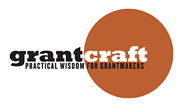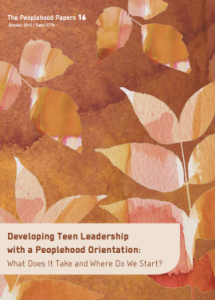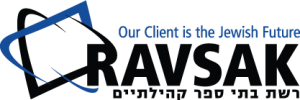As the Jim Joseph Foundation has evolved and matured in its first decade of existence, the professional team has gained invaluable experience. Within the past ten years, both as a means for individual staff to develop professionally and to help meet the Foundation’s strategic goal of contributing tangibly to building the field of Jewish education, Foundation professionals have actively sought opportunities to share insights and lessons learned both at conferences and gatherings. I am pleased to offer a snapshot of this activity below.
At the Jewish Funders Network Conference in April, several members of the Foundation professional team will take part in panel sessions. Senior Program Officer Stacie Cherner will moderate a panel on how to “push evaluation to a new level.” Stacie’s training and experience in evaluation make her a key member of the Jim Joseph Foundation team, working continuously as we do to improve the Foundation’s approach to assessment and to support grantees in generating useful evaluation data and findings.
At this same conference, Foundation Assistant Director Dawne Bear Novicoff will offer a funder perspective on creating strong Jewish early childhood education settings and how those settings can be an entry point for ongoing family engagement in Jewish life. Dawne has been involved with ECE her entire career. She has played a leading role in the Foundation’s growing investment in this area, and she confers regularly with colleagues who are experienced in supporting Jewish early childhood endeavors.
I am looking forward to serving on a JFN pre-conference panel, Scaling Up—Ingredients for Taking Promising Initiatives to the Next Level. I will be joined by David Cygielman of Moishe House, Emily Hall of Olive Grove Consulting, and Aaron Bisman, founder of JDub Records. This panel conversation will be an open and honest look at capacity building efforts in supporting Jewish education.
Prior to the JFN International Conference, members of the Foundation professional team will be at Foundation for Jewish Camp’s (FJC) Leaders Assembly. FJC has been a significant partner of the Foundation, spanning many years and over multiple grants. At the Assembly, we will have opportunities to share Foundation experiences with other funders, describing for them in detail what investment in FJC’s JWest and Jewish specialty camps incubators has taught us.
One of the Foundation’s founding principles is to share lessons learned in an effort to improve the field of Jewish education and, where possible, the broader philanthropic sector. From inception, the Jim Joseph Foundation has interacted extensively with funders and other organizations in the secular philanthropic space. Program Director Josh Miller recently participated in a panel with Lisa Farber Miller of Rose Community Foundation at the Grantmakers for Effective Organizations Collaboration Conference. Together they discussed the evolution of the Jewish Teen Education and Engagement Funder Collaborative. They shared some anticipated outcomes as the Collaborative continues to implement more community-based Jewish teen initiatives.
While Foundation employees’ status as professionals may not be a norm in the Jewish community, there is no doubt that self-reflection of one’s practices—and sharing of these insights in public settings—helps to make the Foundation program officer a more effective grantmaker.
Next month, I also will offer insights to non-profit organizations in the secular arena, as part of a seminar on The Performance Imperative at a conference hosted by the Sanford Institute of Philanthropy. I previously shared The Performance Imperative in this blog. At this seminar, I will discuss both internal grantee monitoring for organizational improvement and external evaluation of foundation-funded initiatives for increased mission effectiveness. This presentation will occur within the context of the seminar’s focus on the seven pillars of high-performing organizations.
Along with these in-person gatherings, the Foundation continues to post grant evaluations on its website. Over the last few months, we have shared evaluations on the Foundation’s Education Initiative—the $45 million investment to HUC-JIR, JTS, and YU to train more Jewish educators—and on the Jewish teen education initiative in Denver/Boulder. In a few weeks, we will feature a model documentation on a successful early childhood education initiative.
Learning individually, together as a Foundation staff, and with peers are critically important professional pursuits. “Ultimately, learning becomes consequential when it is taken up by a range of social groups and, thus, has meaning beyond the local learning community. This begins to stabilize and create value for practices that have become meaningful to a group of participants and are recognized as meaningful beyond the group” (Vadeboncoeur, A. Jennifer and Murray, Dale. “Imagined Futures in the Present: Minding Learning Opportunities.” Learning In and Across Context: Reimagining Education. NSSE, page 646).
The Jim Joseph Foundation team of grantmaking professionals looks forward to ongoing opportunities to reflect on learning, to share insights learned from that discovery, and to engage with colleagues, grantees, and communal leaders in a collective effort to continuously improve the work we do.
 There is a great disparity between the nonprofit organizations that provide services ranging from hunger relief to the arts, and the traditionally slower-to-act philanthropic foundations that fund them. The fastest acting organizations deliver resources immediately to those in need; the more “tortoise”-like foundations engage in diligent planning towards long-term solutions. With this pace spectrum in mind, I think that all parties would benefit by meeting each other midway to work together for longer periods of time leading up to a grant’s proposal and subsequent implementation, creating a more coordinated funder-grantee relationship that enables deeper outcomes.
There is a great disparity between the nonprofit organizations that provide services ranging from hunger relief to the arts, and the traditionally slower-to-act philanthropic foundations that fund them. The fastest acting organizations deliver resources immediately to those in need; the more “tortoise”-like foundations engage in diligent planning towards long-term solutions. With this pace spectrum in mind, I think that all parties would benefit by meeting each other midway to work together for longer periods of time leading up to a grant’s proposal and subsequent implementation, creating a more coordinated funder-grantee relationship that enables deeper outcomes. Over the past several years the Jim Joseph Foundation has invested significant time and resources into deepening our understanding of how the Jewish community can better engage teens in effective, compelling Jewish learning experiences. Two essential lessons we have learned are that:
Over the past several years the Jim Joseph Foundation has invested significant time and resources into deepening our understanding of how the Jewish community can better engage teens in effective, compelling Jewish learning experiences. Two essential lessons we have learned are that: There is an unprecedented level of attention being given to the value and applicability of assessment tools, particularly in the field of education. Certainly this positive development is in part a result of the vast amounts of data seemingly at our fingertips. Practitioners, target audiences, funders, local organizations and other key stakeholders recognize that there are ways to measure the programs, initiatives, curricula, or any other intervention in question. And while not every situation lends itself to assessment, the Jim Joseph Foundation has a guiding principle that if the results of an assessment will inform that educational opportunity and others, then, yes, assess!
There is an unprecedented level of attention being given to the value and applicability of assessment tools, particularly in the field of education. Certainly this positive development is in part a result of the vast amounts of data seemingly at our fingertips. Practitioners, target audiences, funders, local organizations and other key stakeholders recognize that there are ways to measure the programs, initiatives, curricula, or any other intervention in question. And while not every situation lends itself to assessment, the Jim Joseph Foundation has a guiding principle that if the results of an assessment will inform that educational opportunity and others, then, yes, assess!